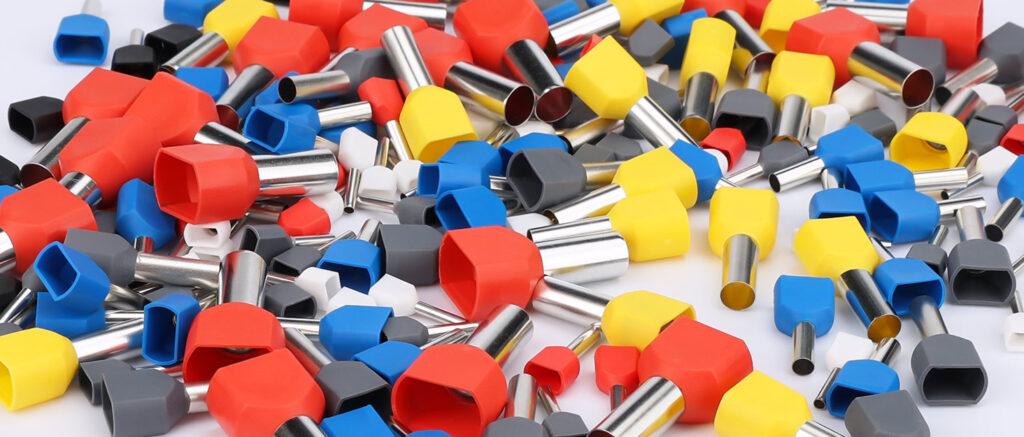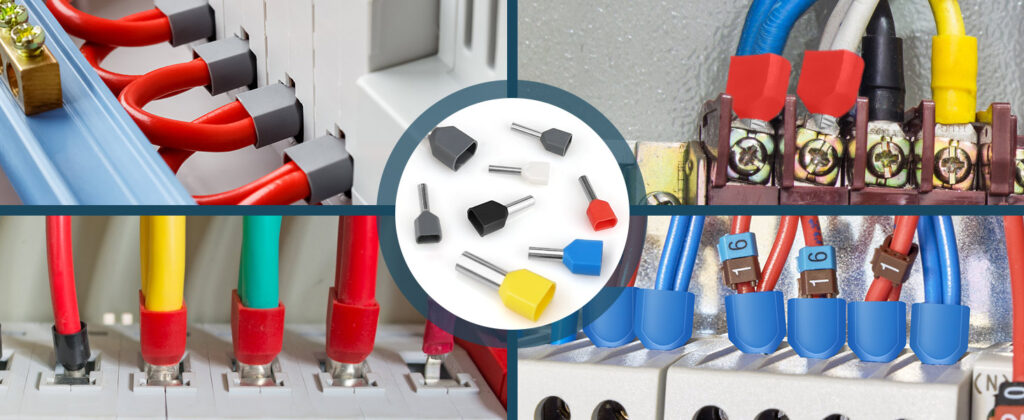Double bootlace ferrules are specialized electrical connectors designed to terminate two wires of the same gauge simultaneously in a single terminal block connection. These cylindrical metal sleeves provide a secure, code-compliant method for connecting multiple conductors while maintaining electrical integrity and safety standards.
Quick Answer: Double bootlace ferrules allow you to safely connect two identical gauge wires into one terminal connection point, eliminating loose strands and ensuring reliable electrical contact in industrial and residential applications.\

Key Definitions and Technical Terms
Bootlace Ferrule: A crimp terminal consisting of a metal tube that accepts stripped wire ends, providing strain relief and preventing wire strand separation.
Double Configuration: Refers to ferrules specifically designed with internal geometry to accommodate exactly two wires of identical gauge.
Terminal Block Connection: The destination point where ferrules connect to electrical equipment, typically featuring screw terminals or spring-loaded connections.
Wire Gauge Compatibility: The specific wire diameter range each ferrule can properly terminate, typically measured in AWG (American Wire Gauge) or mm².
Double vs Single Bootlace Ferrules: Complete Comparison
| Feature | Single Bootlace Ferrules | Double Bootlace Ferrules |
|---|---|---|
| Wire Capacity | One wire per ferrule | Two identical gauge wires |
| Terminal Space | Requires separate terminals | Consolidates to single terminal |
| Installation Time | Individual crimping required | Single crimp for two wires |
| Material Usage | More ferrules needed | Reduces total ferrule count |
| Code Compliance | Standard NEC compliance | Meets NEC 110.14 requirements |
| Cost Efficiency | Higher per-connection cost | Lower overall connection cost |
| Reliability | Excellent single-wire contact | Excellent dual-wire contact |
| Common Gauges | 24 AWG to 10 AWG | 24 AWG to 12 AWG typically |
Applications and Use Cases

Industrial Control Panels
Double bootlace ferrules excel in control panel applications where multiple circuits require common connections to power supplies, grounds, or neutral bars. You use these connectors to:
- Connect dual control circuits to single terminal blocks
- Establish parallel connections for redundant systems
- Reduce terminal block space requirements in compact enclosures
- Maintain clean, professional wire management
Residential Electrical Systems
In residential applications, double ferrules serve specific purposes:
- Sub-panel Connections: Connecting two branch circuits to single neutral or ground bars
- Junction Box Applications: Paralleling conductors in approved junction boxes
- Control System Wiring: HVAC controls requiring multiple identical gauge connections
Commercial Building Systems
Commercial installations benefit from double ferrules in:
- Fire alarm system wiring with duplicate notification circuits
- Security system installations requiring parallel connections
- Building automation systems with redundant control wiring
Technical Specifications and Standards
Wire Gauge Compatibility Chart
| Double Ferrule Size | Compatible Wire Gauge | Maximum Current | Insulation Diameter |
|---|---|---|---|
| 0.5mm² Double | 24 AWG (2 wires) | 3 Amperes | 1.2mm max |
| 0.75mm² Double | 22 AWG (2 wires) | 5 Amperes | 1.4mm max |
| 1.0mm² Double | 20 AWG (2 wires) | 8 Amperes | 1.6mm max |
| 1.5mm² Double | 18 AWG (2 wires) | 12 Amperes | 1.8mm max |
| 2.5mm² Double | 16 AWG (2 wires) | 20 Amperes | 2.2mm max |
Material Construction Standards
- Conductor Material: Electrolytic copper meeting ASTM B49 specifications
- Plating Options: Tin-plated for standard applications, nickel-plated for high-temperature
- Insulation Compatibility: Designed for PVC, XLPE, and rubber insulated conductors
- Operating Temperature: -40°C to +105°C continuous operation
Installation Process: Step-by-Step Guide
Required Tools and Equipment
- Crimping Tool: Dedicated ferrule crimping tool with proper die sets
- Wire Strippers: Precision strippers for consistent strip lengths
- Measuring Tools: Ruler or gauge for accurate strip length measurement
- Safety Equipment: Safety glasses and insulated work gloves
Installation Steps
Step 1: Prepare the Conductors
- Strip both wires to identical lengths (typically 8-10mm)
- Ensure no nicks or cuts in conductor strands
- Verify both wires are identical gauge and construction
Step 2: Select Proper Ferrule Size
- Match ferrule internal diameter to combined wire cross-sectional area
- Confirm ferrule length accommodates both wire strip lengths
- Verify color coding matches wire gauge requirements
Step 3: Insert Wires into Ferrule
- Slide both stripped conductors into ferrule simultaneously
- Ensure conductors extend fully through ferrule length
- Verify no conductor strands protrude from ferrule opening
Step 4: Execute Proper Crimp
- Position ferrule in appropriate crimping tool die
- Apply steady, consistent pressure until crimp cycle completes
- Inspect crimp for proper compression and wire retention
Step 5: Verify Connection Quality
- Perform gentle pull test on both conductors
- Check for proper conductor retention without strand separation
- Confirm ferrule maintains round cross-section after crimping
Safety Requirements and Code Compliance
National Electrical Code (NEC) Requirements
- Section 110.14: Requires proper conductor termination methods
- Section 300.13: Mandates secure conductor connections
- Section 408.3: Specifies panelboard connection requirements for parallel conductors
International Standards Compliance
- IEC 60947-7-4: Low-voltage switchgear ferrule terminal specifications
- UL 486A-486B: Wire connector safety standards
- CSA C22.2: Canadian electrical safety requirements
Safety Considerations
✅ Approved Applications:
- Terminal blocks rated for multiple conductors
- Junction boxes with adequate space for connections
- Control panels meeting manufacturer specifications
❌ Prohibited Uses:
- Circuit breaker terminals not rated for parallel conductors
- Receptacle and switch connections requiring single conductors
- Outdoor applications without proper weatherproofing
Selection Guide: Choosing the Right Double Ferrules
Decision-Making Criteria
Wire Compatibility Assessment:
- Verify both conductors are identical gauge and material
- Confirm insulation type compatibility with ferrule design
- Check temperature rating matches application requirements
Current Capacity Verification:
- Calculate total current for both conductors
- Ensure ferrule ampacity rating exceeds calculated load
- Consider derating factors for elevated temperatures
Terminal Block Compatibility:
- Confirm terminal accepts ferrule external diameter
- Verify adequate torque specifications for ferrule material
- Check manufacturer approval for parallel conductor connections
Quality Indicators
Premium Features to Look For:
- Chamfered Entry: Smooth wire insertion without strand damage
- Inspection Window: Clear plastic sleeve showing proper wire insertion
- Color Coding: Standardized colors matching wire gauge specifications
- Certification Markings: UL, CSA, or CE compliance markings
Troubleshooting Common Installation Issues
Problem: Ferrule Splits During Crimping
Causes: Oversized crimping die, excessive pressure, or low-quality ferrule material
Solution: Verify proper die size selection and adjust crimping tool pressure settings
Problem: Conductors Pull Out After Installation
Causes: Insufficient strip length, improper crimp pressure, or mismatched ferrule size
Solution: Re-strip conductors to proper length and re-crimp with correct pressure
Problem: Poor Terminal Block Connection
Causes: Deformed ferrule shape, inadequate torque, or dirty connection surfaces
Solution: Inspect ferrule integrity and clean terminal surfaces before reassembly
Quick Reference Specifications
Standard Double Ferrule Sizes (AWG)
- 24 AWG Double: 0.5mm² capacity, 3A maximum
- 22 AWG Double: 0.75mm² capacity, 5A maximum
- 20 AWG Double: 1.0mm² capacity, 8A maximum
- 18 AWG Double: 1.5mm² capacity, 12A maximum
- 16 AWG Double: 2.5mm² capacity, 20A maximum
Crimping Tool Requirements
- Ratcheting action for consistent compression
- Interchangeable dies for multiple ferrule sizes
- Calibrated pressure settings
- Ergonomic design for repetitive use
Frequently Asked Questions
What makes double bootlace ferrules different from regular wire nuts?
Double bootlace ferrules provide permanent, code-compliant terminations specifically designed for terminal block connections, while wire nuts create temporary splice connections unsuitable for control panel applications.
Can you use double ferrules on different gauge wires?
No, double bootlace ferrules are engineered for identical gauge conductors only. Mixing wire sizes creates uneven crimping pressure and compromises connection reliability.
Are double ferrules required by electrical code?
While not universally required, many industrial specifications and equipment manufacturers mandate ferrule terminations for reliable control system connections and warranty compliance.
How do you determine the correct strip length for double ferrules?
Strip length should equal the ferrule barrel length minus 1-2mm to ensure full conductor engagement without protrusion. Most ferrules require 8-10mm strip lengths.
Can double ferrules be reused after removal?
No, ferrules are single-use components. The crimping process permanently deforms the metal, and reuse compromises connection integrity and safety.
What’s the maximum current rating for double bootlace ferrules?
Current ratings vary by size, typically ranging from 3A for 24 AWG doubles up to 20A for 16 AWG doubles, always following manufacturer specifications and derating factors.
Do double ferrules work with stranded and solid wire?
Double ferrules are primarily designed for stranded conductors. Solid wire applications typically don’t require ferrules, as solid conductors don’t have strand separation concerns.
How often should ferrule connections be inspected?
Industrial best practices recommend annual visual inspections with periodic torque verification according to equipment manufacturer schedules and local maintenance codes.
Professional Installation Recommendation: For critical applications involving life safety systems, fire alarm circuits, or high-current installations, always consult with certified electrical contractors to ensure proper installation techniques and code compliance. Double bootlace ferrules provide excellent connection reliability when properly selected, installed, and maintained according to manufacturer specifications and electrical safety standards.

